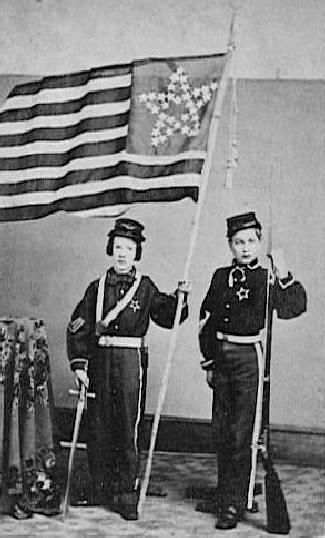
Hill Street School: Civil War (Connecticut)

Figure 1.--Here we see two boys from the Hill Street School. They were part of a boy's school unit--Star Company. (Note the star on their uniforms.) The boys hold a Civil War flag. I counted 28 stars but I could be wrong. The boys are posted with rifle fitted with bayonet and sword. They are Fred Badet and Fred Richards. The portrait was taken about 1862. The CDV was in an album compiled by the Newcomb family.
|
|
The outbreak of the Civil War resulted in an outburst of patriotism, both in the North and South. The school military unit may have been a reflection of this. Of course these boys were too young for actial service, but the Star Company allowed them to show their patriotism and support for the War. Some of their fathers or older brothers probably enlisted. Some of the other images show the boys in military uniform posed with rifles. The portrait here and the related portraits of the boys are interesting because it shows a class and group of boys during the Civil War (1861-65). The boys seem to have formed a school unit--Star Company. They wre uniforms and even had a flag with the stars aranged in a star. There were various ways of arrangeing the stars before and after the War. We are not sure how the School used the military units or if there were others at the school. It seems to have been some kind of patriotic exercise. The boys may have worn the uniforms for drill.
The South was apauled over Abraham Lincoln's election (November 1860). Southern states quickly begn seceeding from the Union and seizing Federal arsenals and forts. President Linsoln wisely allowed the Confedeacy to fire the first shots. Confederate President Jefferson Davis played into his hands. This was a major factor in holding the border states to the Union. The outbreak of violence occurred at Fort Sumter in Charleston Harbor. (April 1861). Confederate battries open fire on the Federal fort. The outbreak of the Civil War resulted in an outburst of patriotism, both in the North and South. The public throughout the North was outraged. Large numbers of men on both sides enlosted. Northern states rushed troops to Wasjington D.C. which was south of the Mason Dixon Line. Most Americans thought it would be a short war. No one fully understood the bloodletting the country was launching upon.
Boys and youth played a major role in the Civil War. The boys and younger teenagers served as teenagers. One author calls it the "Boys' War". Boys only a little olddr than the boys here served on both sides. These boys wre not, however, boys from affluent families and private schools. Mny of the youths who in listed were from rural areas and usually families of modest income and social status.
Children in the North watched the War from afar. Their fathers and brothers may have written home. There wee newspaper and magazines which reported on the War in detail. The invention of the telegraph mean that reports from the battlefield appeared in the paper the next day. Harpers
Hill Stree School: Star Company
The boy's unit formed at Hill Street School was a reflection of the patriotic outburst tht followed the outbreak of War. Of course these boys were too young for actial service, but the Star Company allowed them to show their patriotism and support for the War. Some of their fathers or older brothers probably enlisted. Some of the other images show the boys in military uniform posed with rifles. The portrait here and the related portraits of the boys are interesting because it shows a class and group of boys during the Civil War (1861-65). The boys seem to have formed a school unit--Star Company. They wre uniforms and even had a flag with the stars aranged in a star. There were various ways of arrangeing the stars before and after the War. We are not sure how the School used the military units or if there were others at the school. It seems to have been some kind of patriotic exercise. The boys may have worn the uniforms for drill. We notice several other portraits of the boys: Fred Latimer and Colby Jeffrey and Fred Newcomb and Wolcott Daboll.
HBC

Related Chronolgy Pages in the Boys' Historical Web Site
[Main Chronology Page]
[The 1900s]
[The 1910s]
[The 1920s]
[The 1930s]
[The 1940s]
[The 1950s]
[The 1960s]
[The 1970s]
[The 1980s]
[The 1990s]
[The 2000s]
Navigate the Relate Boys Historical Clothing Style Pages
[First Communion]
[Confirmation]
[Long pants suits]
[Short pants suits]
[Kneepants]
[Knickers]
[Kneesocks]
[Long stockings]
[Eton suits]
[Jacket and trousers]
[Button-on clothing]
[Blazer]
[School sandals]
[Bangs]
Navigate the Boys' Historical Clothing School Uniform Pages
[Return to the Main Hill Stree School page]
[Return to the Main U.S. individual school chronology page]
[Return to the Main National School Uniform Page]
[Australia]
[England]
[France]
[Germany]
[Ireland]
[Italy]
[Japan]
[New Zealand]
[Poland]
[Singapore]
[Scotland]
[Singapore]
Navigate the Boys' Historical Clothing Web Page
[Introduction]
[Activities]
[Biographies]
[Chronology]
[Clothing styles]
[Countries]
[Girls]
Musical instruments]
[Bibliographies]
[Contributions]
[FAQs]
[Glossaries]
[Images]
[Registration]
[Tools]
[Boys' Clothing Home]
Created: 2:03 AM 9/19/2007
Last updated: 2:03 AM 9/19/2007




